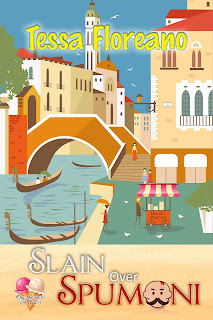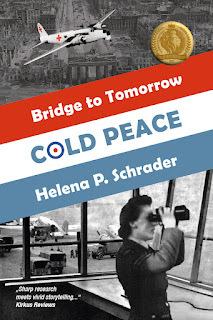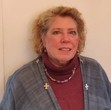Why I Write Historical Fiction - A Guest Blogpost from Teresa Goertz
Tessa Floreano is an author and community historian who lives near Seattle, but considers Vancouver and Venice her second homes. She writes historical tales about Italians, with a gallon of mystery and a pint of romance thrown in for good measure. Her stories are set mainly in the Pacific Northwest and Europe, though a few are in New York City and San Francisco, just because she has a strong pull to the Italians in both those cities, too. Coming Winter 2024 is a romantic mystery set in 1899 in Italy at Christmas involving murder, matrimony, and mayhem, oh my!

Inpalmistry, a square atop Jupiter's mount signifies a teacher's box. Unlike myhusband, no such pronounced formation exists on my palm. If it did, I imagineit might provide the impetus to teach historical fiction—a genre towhich I am intensely and increasingly drawn. Rather than a classroom as myteaching box, I use the power of the pen to scribe stories, both real andimagined. Some kind readers have even insisted that I am teaching, though perhaps in a lessstructured way. Hopefully, more entertaining, too. And why do I prefer to writewords about history rather than speak them? Read on, fair reader.
Asan impressionable youngster, I devoured historical fiction. Betwixt the pagesof fairy tales and fantastic yarns of yore, my imagination soared unobstructed.I had never visited a Saxon fortress, worn a Roman toga, or witnessed a Saharansandstorm, reading about medieval knights, ancient senators, or whirlingdervishes in faraway places allowed me to dream and put myself in someoneelse's shoes; or rather, smack in the middle of their adventures andmisadventures.
Growing up, I didnot come across stories about girls like me whose parents were immigrants,spoke with a funny accent, and whose customs and traditions did not fit themainstream. Thus, I escaped into what was available, like The Borrowers, Anneof Green Gables, Little House on the Prairie, and Nancy Drew. Eventually, thesenear-contemporary stories fell short. To ease the ache for something moreenticing, I glommed onto the classics set in foreign lands, like The Count ofMonte Cristo, Anna Karenina, and The Hound of the Baskervilles.
As I got older,and soon after my father died, I delved headlong into our family's past. Therewere many questions I did not get to ask my father, so I dug into our familytree and that is when the stories started to pop. Though my genealogy isincomplete, I turned to stories about other Italians. Some reflected my ownnorthern Italian heritage that surrounded me in my Canadian hometown ofVancouver. Some were based on southern Italian ancestry, by far the largestgroup I encountered when I emigrated to the Seattle area.
Fastforward to today where I write through a lens colored by a variety of Italianhistory, herstory, and heritage—some fictionalized, some not. Through thesetales, I share what I know, love, and am curious about. Always, they include animaginative reconstruction of historical events and Italian personages that Ifind fascinating and yearn to learn more about. My curiosity drives my researchand storytelling. Both mundane and obscure items can start me off. I satiate mycuriosity when I fall deeper down the rabbit hole after finding a gem or twothat I know I can develop further.
Toeducate myself and ensure I am getting as accurate a picture as I can ofpeople, places, events, and the vernacular of the time, I draw on primary andsecondary sources to give depth and nuance. Primary sources include documentsand artifacts—personal letters, oral interviews, diaries, carte de visites,calling cards, photographs, newspapers, advertisements, maps, and governmentdocuments. Secondary sources include scholarly articles, illuminatedmanuscripts, black and white movies, and old books with wonderful and strangebon mots in the margins. I seek out that which supports my story, thoughoccasionally the words and objects I find completely change the trajectory Ihad planned, be it for the plot, characters, or theme.
Throughoutmy story, I weave one or more themes—love, hate, betrayal, loyalty, bravery,cowardice, survival, power, secrets—making sure my protagonists and antagonistsdrive the problems and solutions. My characters are not automatons, and theyexperience things in different ways and filter them through their own ideas,prejudices, understandings, and misunderstandings, specific to their time. WhenI begin to tell my tale, I make a choice about what historical words to use,what to emphasize, what to leave out, and so on. I might imagine a situationwhere one of my newly arrived Italian immigrants witnesses a brawl. AnEnglish-speaking American who understands what everyone is saying—from thevictim to the first responders to the perpetrator—might offer a vastlydifferent view than a foreigner who does not understand the language or thelaw. Therefore, I have to factor that in to how the scene unfolds and thecharacters behave, and that is where the opportunities and challenges lie.
Ienjoy juxtaposing political, social, cultural, and religious views and biasesof yesterday without imposing those of today onto my characters. If I do my jobwell, I can use my stories to not only show readers what happened in the past,but how it has shaped the present. And I have to do it intentionally. Forexample, I have a great idea for a dual timeline story. You can bet that mycharacters will—at some point—say that they must not change the annals whenjumping chronology, regardless of how tempting, especially if there's dangerafoot. I have to respect that because historical fiction has some rules, mostof which I adhere to (wink wink).
Iam careful when I bring in historical events and how I manage them. Here is anexample: Let's say that in my interwar series, Roosevelt announcesthe New Deal with great fanfare. Rather than having a character read about itin a newspaper, I can use a conversation between characters to help my readersunderstand the implications for Italians of the programs and public worksprojects that took place in that era. I could show how the first ItalianRepublican congresswoman in her state, who did not want the New Deal, reacts toit. Conversely, I might show how a Dust Bowl farmer benefited eventually fromthe President’s reforms and the life changes he and his Italian familyexperience because of the impact on their finances.
Actually,I would not be able to use the first example because the first Italian Americanwoman to serve in Congress did not happen until 1970, many decades after theDepression, which is the time period of my series. You might have thought Idigressed there for a moment, but double-checking my facts is a big part of whyI love writing about history.
Sometimes,a fact just will not work within the timeline I chose, and I either have toleave it out, or include a mention of my fabricated use of it in my Author'sNote, and why it is plausible. Critics, ahem, sticklers for one hundred percentfactual historical detail, will bemoan that I use the Author's Note as acrutch. They will argue that it is how I justify why I wrote certain events outof context or included details about real personages that were not real. Theymight even write off my story because of it.
Ido not argue with people who feel that way, however, I reserve the right to usesuch a device to inform, and yes, even teach my readers. It is a space I holdsacrosanct. It is where I exhale and reveal my raw side, including my sources,inspiration, methods, and hope for the book's place in the world. I usethe Author's Note like an informal letter to my readers—to give deepermeaning to my story, some accountability, and a more objective understanding ofthe history. If I change facts to suit the story's timeline, I owe it to myreaders to be transparent about why, and I believe they will respect me for it.
Mostreaders love that intimate connection that my Author's Note provides becausethey know I spent the time speaking directly to them. Usually, I include extrainformation that adds a new dimension to the story they just read and I amtickled when they embrace it. Some readers have shared that it leads them downtheir own rabbit holes of history, and that makes the effort of writing aboutwhat I am learning all the more satisfying.
Towrite is to learn, and this is true for me, especially as it relates tohistorical fiction. It has staying power in my writing (and teaching) life,even if I am short of one geometric square imprinted on my skin.
 Find out more about Tessa’s books on her website https://tessafloreano.com and by signing up for her newsletter
Find out more about Tessa’s books on her website https://tessafloreano.com and by signing up for her newsletter
Blog Host Helena P. Schrader is the author of 25 historical fiction and non-fiction books, eleven of which have one one or more awards. You can find out more about her, her books and her awards at: https://helenapschrader.com
Her most recent release, Cold Peace, was runner-up for the Historical Fiction Company BOOK OF THE YEAR 2023 Award, as well as winning awards from Maincrest Media and Readers' Favorites. Find out more at: https://www.helenapschrader.com/cold-peace.html




